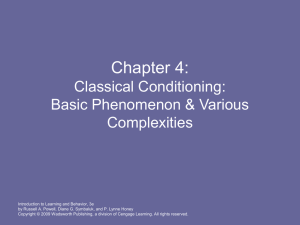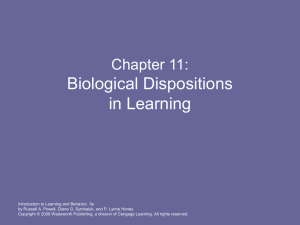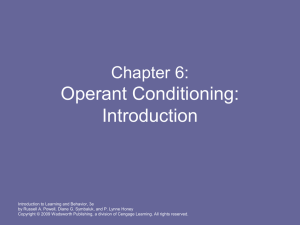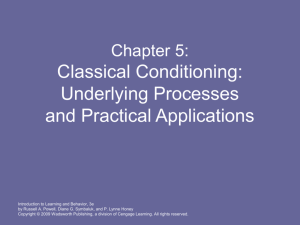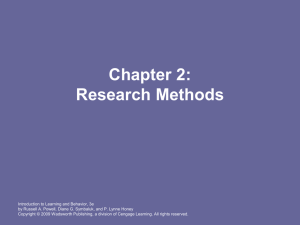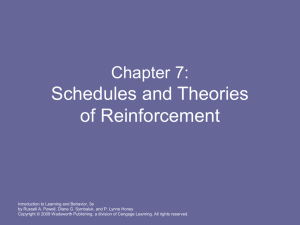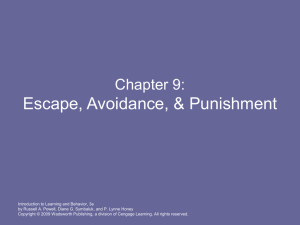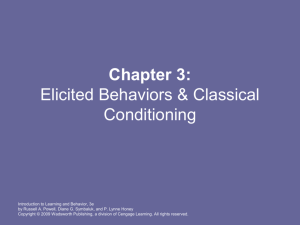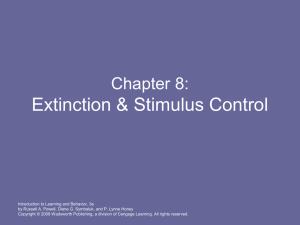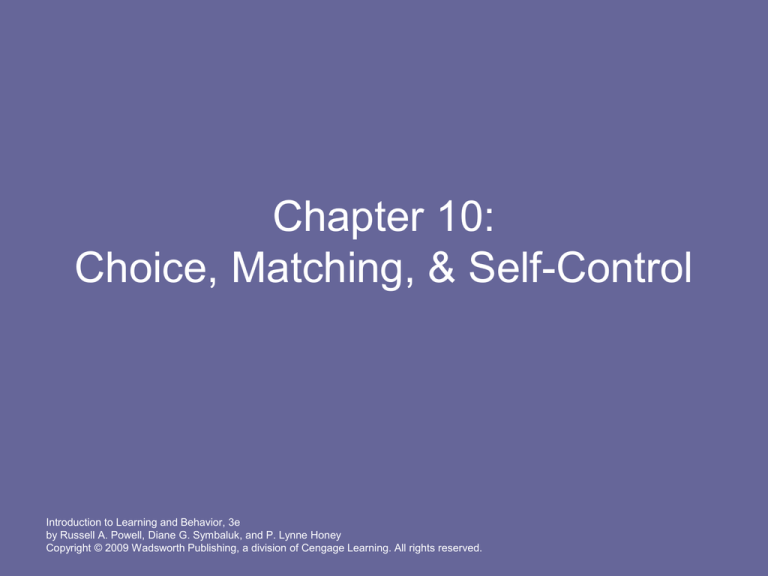
Chapter 10:
Choice, Matching, & Self-Control
Introduction to Learning and Behavior, 3e
by Russell A. Powell, Diane G. Symbaluk, and P. Lynne Honey
Copyright © 2009 Wadsworth Publishing, a division of Cengage Learning. All rights reserved.
In Real Situations
• Operant conditioning is rarely a matter of
being offered only one source of
reinforcement.
• Instead, individuals typically choose
between alternative sources of
reinforcement.
Introduction to Learning and Behavior, 3e
by Russell A. Powell, Diane G. Symbaluk, and P. Lynne Honey
Copyright © 2009 Wadsworth Publishing, a division of Cengage Learning. All rights reserved.
Concurrent Schedules of
Reinforcement
• the simultaneous presentation of two or
more independent schedules, each
leading to a reinforcer.
• The organism is thus allowed a choice.
• Example:
– A pigeon can choose between responding on
a red key with a VR 20 schedule and a green
key with a VR 50 schedule.
Introduction to Learning and Behavior, 3e
by Russell A. Powell, Diane G. Symbaluk, and P. Lynne Honey
Copyright © 2009 Wadsworth Publishing, a division of Cengage Learning. All rights reserved.
The Matching Law
• the proportion of responses emitted on a
particular schedule matches the proportion of
reinforcers obtained on that schedule.
• Example:
– A pigeon will emit approximately twice as many
responses on the VI 30-sec schedule as on the VI 60sec schedule.
• The matching law predicts a consistent
relationship between the proportion of
reinforcers and the proportion of responses.
Introduction to Learning and Behavior, 3e
by Russell A. Powell, Diane G. Symbaluk, and P. Lynne Honey
Copyright © 2009 Wadsworth Publishing, a division of Cengage Learning. All rights reserved.
Matching Law Equation
RA
RA + RB
•
•
•
•
=
SRA
.
SRA + SRB
RA - number of responses emitted on schedule A
RB - number of responses emitted on schedule B
SRA - number of reinforcers earned on schedule A
SRB is the number of reinforcers earned on
schedule B
Introduction to Learning and Behavior, 3e
by Russell A. Powell, Diane G. Symbaluk, and P. Lynne Honey
Copyright © 2009 Wadsworth Publishing, a division of Cengage Learning. All rights reserved.
Equation Example
• Use hypothetical data from an experiment
involving a choice between a VI 30-sec and a VI
60-sec schedule.
• Our hypothetical pigeon obtains 119 reinforcers
on the VI 30- sec schedule and 58 reinforcers
(about half as many) on the VI 60-sec schedule.
• Our hypothetical pigeon emits 2,800 responses
on the VI 30-sec schedule and 1,450 responses
on the VI 60-sec schedule.
Introduction to Learning and Behavior, 3e
by Russell A. Powell, Diane G. Symbaluk, and P. Lynne Honey
Copyright © 2009 Wadsworth Publishing, a division of Cengage Learning. All rights reserved.
Equation Example, continued
• The proportion of responses emitted on
the VI 30-sec schedule is .66.
• The proportion of reinforcement obtained
on that schedule was .67).
Introduction to Learning and Behavior, 3e
by Russell A. Powell, Diane G. Symbaluk, and P. Lynne Honey
Copyright © 2009 Wadsworth Publishing, a division of Cengage Learning. All rights reserved.
Conger and Killeen (1974) Study of
Matching in Humans
• They asked volunteers to participate with three
others in a discussion session on drug abuse.
• While the volunteer was talking, the two
confederates sat on either side and intermittently
expressed approval.
• They found that the relative amount of time the
volunteer looked at each confederate matched
the relative frequency of verbal approval
delivered by that confederate.
Introduction to Learning and Behavior, 3e
by Russell A. Powell, Diane G. Symbaluk, and P. Lynne Honey
Copyright © 2009 Wadsworth Publishing, a division of Cengage Learning. All rights reserved.
Undermatching
• the proportion of responses is less different than
would be predicted by matching.
• Example:
– The matching law predicts that the proportion of
responses should be .67 on the richer VI 30-sec
schedule and .33 on the poorer VI 60-sec schedule.
– If we instead find proportions of .60 and .40,
respectively, then undermatching has occurred.
• Undermatching can occur when there is little
cost for switching from one schedule to another.
Introduction to Learning and Behavior, 3e
by Russell A. Powell, Diane G. Symbaluk, and P. Lynne Honey
Copyright © 2009 Wadsworth Publishing, a division of Cengage Learning. All rights reserved.
Changeover Delay (COD)
• a slight delay of during which no response
will be effective in producing a reinforcer,
even if a reinforcer happens to be
available at that time.
• A slight cost for switching between
schedules can be added to reduce
undermatching.
• Example:
– A 2-second delay on reinforcers.
Introduction to Learning and Behavior, 3e
by Russell A. Powell, Diane G. Symbaluk, and P. Lynne Honey
Copyright © 2009 Wadsworth Publishing, a division of Cengage Learning. All rights reserved.
Overmatching
• the proportion of responses on the richer
schedule versus the poorer schedule is more
different than would be predicted by matching.
• Example:
– The matching law predicts that the proportion of
responses should be .67 on the richer VI 30-sec
schedule and .33 on the poorer VI 60-sec schedule.
– If we instead find proportions of .80 and .20,
respectively, then overmatching has occurred.
Introduction to Learning and Behavior, 3e
by Russell A. Powell, Diane G. Symbaluk, and P. Lynne Honey
Copyright © 2009 Wadsworth Publishing, a division of Cengage Learning. All rights reserved.
Overmatching, continued
• Overmatching can occur when the cost of
moving from one alternative to another is
very high.
• Example:
– A pigeon had to walk around a partition and
climb across a wooden hurdle to switch from
one response key to another.
Introduction to Learning and Behavior, 3e
by Russell A. Powell, Diane G. Symbaluk, and P. Lynne Honey
Copyright © 2009 Wadsworth Publishing, a division of Cengage Learning. All rights reserved.
Bias from Matching
• when one alternative attracts a higher proportion of
responses than would be predicted by matching.
• This happens regardless of whether that alternative
contains the richer or poorer schedule of reinforcement.
• Example:
– The matching law predicts that the proportion of responses
on the red key should be .67 on the rich schedule and .33
on the poorer schedule.
– If the proportions instead turned out to be .77 on the rich
schedule and .43 on the poor schedule, then bias has
occurred.
Introduction to Learning and Behavior, 3e
by Russell A. Powell, Diane G. Symbaluk, and P. Lynne Honey
Copyright © 2009 Wadsworth Publishing, a division of Cengage Learning. All rights reserved.
Example of Bias from Matching in
Humans
• Erin might spend additional time directing her
conversation toward Jason, whom she finds very
attractive.
• On one day, he provides 72% of the reinforcers
during a conversation, but she nevertheless
looks at him 84% of the time.
• On another day, he provides only 23% of the
reinforcers, but she nevertheless looks at him
36% of the time.
• In each case, she looks at him more than would
be predicted by matching.
Introduction to Learning and Behavior, 3e
by Russell A. Powell, Diane G. Symbaluk, and P. Lynne Honey
Copyright © 2009 Wadsworth Publishing, a division of Cengage Learning. All rights reserved.
Bias from Matching & Preference
• Bias in matching can be used to indicate degree
of preference for different reinforcers.
• Example:
– On a concurrent VI 60-sec VI 60-sec schedule, the
pigeon should respond equally.
– If each alternative leads to a different reinforcer, the
higher response rate or bias toward one schedule
may indicate reiforcer preference.
Introduction to Learning and Behavior, 3e
by Russell A. Powell, Diane G. Symbaluk, and P. Lynne Honey
Copyright © 2009 Wadsworth Publishing, a division of Cengage Learning. All rights reserved.
Example of Preference
• Although a child might spend little time reading,
this does not mean that reading is not a
reinforcing activity for that child.
• If other highly reinforcing activities happen to be
simultaneously available, reading may be losing
out.
• Limit the amount of time those other activities
are available.
• The child might naturally gravitate toward
reading.
Introduction to Learning and Behavior, 3e
by Russell A. Powell, Diane G. Symbaluk, and P. Lynne Honey
Copyright © 2009 Wadsworth Publishing, a division of Cengage Learning. All rights reserved.
Melioration Theory
• the distribution of behavior in a choice situation
shifts toward those alternatives that have higher
value regardless of the long-term effect on the
overall amount of reinforcement.
• Example:
– The VI 30-sec schedule will have a much higher value
than the VI 60-sec schedule.
– The pigeon will be tempted in subsequent sessions to
shift more and more of its behavior in that direction.
Introduction to Learning and Behavior, 3e
by Russell A. Powell, Diane G. Symbaluk, and P. Lynne Honey
Copyright © 2009 Wadsworth Publishing, a division of Cengage Learning. All rights reserved.
Melioration Theory, continued
•
•
Melioration in this situation is thus a sort of leveling out
process, in which behavior shifts until the two
alternatives have about equal value in costs versus
benefits.
The tendency to move toward the richer alternative can
sometimes result in a substantial reduction in the total
amount of reinforcement obtained, because:
1. the alternative may not require as much responding
2. overindulgence in a highly reinforcing alternative can often
result in long-term habituation
3. melioration is often the result of behavior being too strongly
governed by immediate consequences
Introduction to Learning and Behavior, 3e
by Russell A. Powell, Diane G. Symbaluk, and P. Lynne Honey
Copyright © 2009 Wadsworth Publishing, a division of Cengage Learning. All rights reserved.
1. An Alternative May Not Require
As Much Responding
• Example:
– A pigeon obtains 60% of its reinforcers from the VI
30-sec schedule.
– It will spend 60% of its time responding on the VI 30sec schedule and only 40% of its time responding on
the VR 100 schedule.
– However, the pigeon should spend most of its time on
the VR schedule because the number of reinforcers
obtained is directly tied to the number of responses
made.
– The pigeon should briefly switch to the VI alternative
every 30 seconds to pick up any reinforcer that might
have become available on that alternative.
Introduction to Learning and Behavior, 3e
by Russell A. Powell, Diane G. Symbaluk, and P. Lynne Honey
Copyright © 2009 Wadsworth Publishing, a division of Cengage Learning. All rights reserved.
Another Example
• Students often spend the most time studying for
their most enjoyable course and the least time
studying for their least enjoyable course.
• Yet the least enjoyable course is probably the
one on which students should spend the most
time studying.
• The result is that they spend the least time
studying those courses that require the most
work.
Introduction to Learning and Behavior, 3e
by Russell A. Powell, Diane G. Symbaluk, and P. Lynne Honey
Copyright © 2009 Wadsworth Publishing, a division of Cengage Learning. All rights reserved.
2. Overindulgence Can Result In
Long-term Habituation
• Example:
– You suddenly become so rich that you can eat
as much as you want of whatever you want,
such as lobster.
– The problem is that if you eat lobster this
frequently, you will likely become habituated
to it.
– Although it is still enjoyable, it is no longer the
heavenly treat that it once was.
Introduction to Learning and Behavior, 3e
by Russell A. Powell, Diane G. Symbaluk, and P. Lynne Honey
Copyright © 2009 Wadsworth Publishing, a division of Cengage Learning. All rights reserved.
Another Example
• If drinking in a bar is a highly enjoyable activity,
you might begin shifting more and more of your
behavior in that direction.
• Eventually, you will be spending so much time in
the bar that the overall amount of reinforcement
in your life is substantially reduced.
• Drinking is no longer as enjoyable and you are
missing out on reinforcers from other
nonalcohol-related activities.
Introduction to Learning and Behavior, 3e
by Russell A. Powell, Diane G. Symbaluk, and P. Lynne Honey
Copyright © 2009 Wadsworth Publishing, a division of Cengage Learning. All rights reserved.
3. Behavior Is Governed By
Immediate Consequences
• Examples:
– The immediate reinforcement available from studying
more enjoyable courses tempts one away from
working on less enjoyable courses and maximizing
one’s overall grade point average at the end of the
term.
– The immediate reinforcement available from going to
the bar each evening tempts one away from
moderating one’s drinking and eventually establishing
a more healthy and satisfying lifestyle.
Introduction to Learning and Behavior, 3e
by Russell A. Powell, Diane G. Symbaluk, and P. Lynne Honey
Copyright © 2009 Wadsworth Publishing, a division of Cengage Learning. All rights reserved.
Self-Control
• Examples of a lack of self-control:
– You decide to quit smoking but do not persist
more than a day,
– You are determined to go for a run each
morning but cannot get out of bed to do so.
– You resolve to study each evening but spend
most evenings either watching television or
socializing.
Introduction to Learning and Behavior, 3e
by Russell A. Powell, Diane G. Symbaluk, and P. Lynne Honey
Copyright © 2009 Wadsworth Publishing, a division of Cengage Learning. All rights reserved.
Self-Control & Willpower
• A person who behaves wisely and resists
temptations is said to have a lot of willpower,
whereas a person who behaves poorly and
yields to temptations is said to have little
willpower.
• Willpower merely describes what someone did.
• It does not explain why he was able to do it.
• Example:
– Someone trying to quit smoking.
Introduction to Learning and Behavior, 3e
by Russell A. Powell, Diane G. Symbaluk, and P. Lynne Honey
Copyright © 2009 Wadsworth Publishing, a division of Cengage Learning. All rights reserved.
Skinner on Self-Control
•
Managing conflicting outcomes involves two
types of responses:
–
•
a controlling response that serves to alter the
frequency of a controlled response
Example:
–
–
To control the amount of money you spend you
leave most of your money at home when heading
out one evening (controlling response).
The amount you subsequently spend is the
controlled response.
Introduction to Learning and Behavior, 3e
by Russell A. Powell, Diane G. Symbaluk, and P. Lynne Honey
Copyright © 2009 Wadsworth Publishing, a division of Cengage Learning. All rights reserved.
Types of Controlling Responses
• Physical Restraint
– Examples: Leaving money at home or loaning
your television set to a friend for the semester
• Depriving and Satiating
– Examples: skip lunch before an expensive
dinner or shop for groceries after a meal
• Doing Something Else
– Example: chew gum to help you stop smoking
Introduction to Learning and Behavior, 3e
by Russell A. Powell, Diane G. Symbaluk, and P. Lynne Honey
Copyright © 2009 Wadsworth Publishing, a division of Cengage Learning. All rights reserved.
Types of Controlling Responses,
continued
• Self-Reinforcement and Self-Punishment
– Example: You promise to have a pizza after
completing 3 hours of studying or you promise to do
20 push-ups following each cigarette smoked.
– The problem is keeping yourself from cheating.
– Self-delivered consequences are more effective when
the person perceives that other people are aware of
the contingency.
– Self-delivered contingencies are a recommended
component of many self-management programs.
Introduction to Learning and Behavior, 3e
by Russell A. Powell, Diane G. Symbaluk, and P. Lynne Honey
Copyright © 2009 Wadsworth Publishing, a division of Cengage Learning. All rights reserved.
The Temporal Issue
• Immediate consequences are generally more
powerful than delayed consequences.
• Self-control involves choosing the larger later
reinforcer over the smaller sooner reinforcer.
• Example:
– A student who can either go out for the evening and
have a good time or study in the hopes of achieving
an excellent grade.
Introduction to Learning and Behavior, 3e
by Russell A. Powell, Diane G. Symbaluk, and P. Lynne Honey
Copyright © 2009 Wadsworth Publishing, a division of Cengage Learning. All rights reserved.
The Temporal Issue, continued
• Self-control involves the choice between a
smaller sooner punisher and a larger later
punisher.
• Example:
– In deciding whether to go to the dentist, we
choose between
• enduring a small amount of discomfort now from
minor dental treatment and
• risking a large amount of discomfort from an
infected tooth in the distant future.
Introduction to Learning and Behavior, 3e
by Russell A. Powell, Diane G. Symbaluk, and P. Lynne Honey
Copyright © 2009 Wadsworth Publishing, a division of Cengage Learning. All rights reserved.
It isn’t a simple choice!
• Example:
– Choosing not to smoke leads to both
• a smaller sooner punisher in the form of withdrawal
symptoms and
• a larger later reward in the form of improved health.
– Continuing to smoke leads to both
• a smaller sooner reward in the form of a nicotine high
and
• a larger later punisher in the form of deteriorating
health.
Introduction to Learning and Behavior, 3e
by Russell A. Powell, Diane G. Symbaluk, and P. Lynne Honey
Copyright © 2009 Wadsworth Publishing, a division of Cengage Learning. All rights reserved.
Delayed Consequences
• often present a sort of double whammy.
• Their value is weakened because they are
delayed and because they are less
certain.
• Example:
– There is no guarantee that you will become
sick and die if you continue to smoke, nor is
there any guarantee that you will become
radiantly healthy if you quit smoking.
Introduction to Learning and Behavior, 3e
by Russell A. Powell, Diane G. Symbaluk, and P. Lynne Honey
Copyright © 2009 Wadsworth Publishing, a division of Cengage Learning. All rights reserved.
Delay of Gratification Task
• the task of choosing between a smaller sooner
reinforcer and a larger later reinforcer.
• The person or animal must forgo the smaller
sooner reward to obtain the larger later reward.
• The subject has to “delay gratification.
• Self-control consists of choosing a larger later
reward over a smaller sooner reward.
• Impulsiveness consists of choosing a smaller
sooner reward over a larger later reward.
Introduction to Learning and Behavior, 3e
by Russell A. Powell, Diane G. Symbaluk, and P. Lynne Honey
Copyright © 2009 Wadsworth Publishing, a division of Cengage Learning. All rights reserved.
Mischel’s Delay of Gratification
Paradigm
• The earliest systematic research using a delay-ofgratification procedure was carried out by Walter
Mischel.
• A child was led into a room that contained two items, one
of which was clearly preferred.
• The child was told that he or she could attain the
preferred item by simply waiting for the experimenter to
return.
• If the child wished, however, the experimenter could be
summoned by sounding a signal, at which point the child
received only the smaller, nonpreferred item.
Introduction to Learning and Behavior, 3e
by Russell A. Powell, Diane G. Symbaluk, and P. Lynne Honey
Copyright © 2009 Wadsworth Publishing, a division of Cengage Learning. All rights reserved.
Mischel’s Delay of Gratification
Paradigm, continued
• The question of interest was to see what sorts of
strategies some children used to wait out the delay
period and obtain the larger reward.
• Some children simply averted or covered their eyes from
the promised rewards.
• Other children did something else to distract themselves.
• Children who focused on abstract qualities of the object
did better.
• Follow-up studies revealed that the children who had
waited for preferred rewards were more cognitively and
socially competent.
Introduction to Learning and Behavior, 3e
by Russell A. Powell, Diane G. Symbaluk, and P. Lynne Honey
Copyright © 2009 Wadsworth Publishing, a division of Cengage Learning. All rights reserved.
The Reversal
• At an early point in time, when both rewards are still
distant, the larger later reward (LLR) is clearly preferred.
• As time passes, however, and the smaller sooner reward
(SSR) becomes imminent, its value increases sharply
and comes to outweigh the value of the LLR.
• Example:
– The student who, when she wakes up in the morning, decides
that she will definitely study that evening is at the far left.
– As evening approaches, however, and the possibility of going out
(the SSR) becomes imminent, the student will be strongly
tempted to socialize that evening.
Introduction to Learning and Behavior, 3e
by Russell A. Powell, Diane G. Symbaluk, and P. Lynne Honey
Copyright © 2009 Wadsworth Publishing, a division of Cengage Learning. All rights reserved.
Reversal Graph
Introduction to Learning and Behavior, 3e
by Russell A. Powell, Diane G. Symbaluk, and P. Lynne Honey
Copyright © 2009 Wadsworth Publishing, a division of Cengage Learning. All rights reserved.
Reversal Studies
• Examples:
– Pigeons presented with two choices:
• a peck on the red key resulting in 2-sec access to grain
following a 20-sec delay (the SSR) or
• a peck on the green key resulted in 6-sec access to grain
following a 24-sec delay (the LLR).
– Humans choosing between:
• a $100 certified check that can be immediately cashed or
• a $200 certified check that can be cashed in 2 years.
Introduction to Learning and Behavior, 3e
by Russell A. Powell, Diane G. Symbaluk, and P. Lynne Honey
Copyright © 2009 Wadsworth Publishing, a division of Cengage Learning. All rights reserved.
Changing the Shape of the Delay
Function for LLR
• The basic reason preference reversal occurs is
because the LLR has low value at long delays.
• There appear to be innate differences in
impulsivity between species.
• There may also be differences between
individuals, with some individuals more
impulsive than others.
• People become less impulsive as they grow
older.
• Repeated experience with responding for
delayed rewards impacts impulsiveness.
Introduction to Learning and Behavior, 3e
by Russell A. Powell, Diane G. Symbaluk, and P. Lynne Honey
Copyright © 2009 Wadsworth Publishing, a division of Cengage Learning. All rights reserved.
Changing the Shape of the Delay
Function for LLR, continued
• The availability of other sources of
reinforcement may be yet another factor
that influences impulsiveness.
• We can more easily maintain responding
for a distant goal by setting up an explicit
series of subgoals.
Introduction to Learning and Behavior, 3e
by Russell A. Powell, Diane G. Symbaluk, and P. Lynne Honey
Copyright © 2009 Wadsworth Publishing, a division of Cengage Learning. All rights reserved.
Commitment Response
• an action carried out at an early point in time that
serves either to eliminate or greatly reduce the
value of an upcoming temptation.
• Example:
– To ensure that she studies tonight, she gives her
younger brother $20 in the morning and instructs him
to keep it if she fails to study that evening.
– The aversive consequence that would result from not
studying has reduced the value of any alternate
activity and the larger later reward of obtaining a good
mark.
Introduction to Learning and Behavior, 3e
by Russell A. Powell, Diane G. Symbaluk, and P. Lynne Honey
Copyright © 2009 Wadsworth Publishing, a division of Cengage Learning. All rights reserved.
Behavioral Contracting
• a person formally arranges to attain
certain rewards for resisting temptation or
receive certain punishers for yielding to
temptation.
• The contract is negotiated with a therapist.
• The contingencies outlined in the contract
serve to reduce the attractiveness of the
tempting alternative.
Introduction to Learning and Behavior, 3e
by Russell A. Powell, Diane G. Symbaluk, and P. Lynne Honey
Copyright © 2009 Wadsworth Publishing, a division of Cengage Learning. All rights reserved.
Even Pigeons Can Make
Commitements
• In Rachlin and Green’s study (1972),
pigeons were then given the option of
pecking another key that would eliminate
the SSR as one of the choices and leave
the LLR as the only alternative.
• Many of the pigeons selected this option,
thereby essentially removing the
temptation ahead of time.
Introduction to Learning and Behavior, 3e
by Russell A. Powell, Diane G. Symbaluk, and P. Lynne Honey
Copyright © 2009 Wadsworth Publishing, a division of Cengage Learning. All rights reserved.
Small-But-Cumulative Effects
Model
• Each choice of an SSR versus LLR has only a
small but cumulative effect on reaching our
goals.
• This is why self-control is so difficult.
• Example:
– Choosing between a restaurant’s world famous
Greaze-Burger and their far healthier, but much less
appetizing, Tofu Salad Supreme, when trying to
maintain a healthy lifestyle.
– It is only because that one burger is unlikely to result
in punishing outcomes that its value can rise so
sharply.
Introduction to Learning and Behavior, 3e
by Russell A. Powell, Diane G. Symbaluk, and P. Lynne Honey
Copyright © 2009 Wadsworth Publishing, a division of Cengage Learning. All rights reserved.
Improving Self-Control
• Develop a plan to handle occasional lapses.
• Establish rules that clearly distinguish between
acceptable and unacceptable behaviors.
• The actual point when an impulsive behavior
becomes harmful is often not clear.
• The clearest rule might be total abstinence from
a tempting event.
• Example:
– Alcoholics Anonymous’ rule of never, ever consuming
alcohol
Introduction to Learning and Behavior, 3e
by Russell A. Powell, Diane G. Symbaluk, and P. Lynne Honey
Copyright © 2009 Wadsworth Publishing, a division of Cengage Learning. All rights reserved.
Summary
• A concurrent schedule provides opportunity to
respond on two or more independent schedules
that are simultaneously available.
• Choice behavior in such situations often obeys
the matching law.
• There are certain deviations from matching:
– Undermatching
– Overmatching
– Bias from Matching
Introduction to Learning and Behavior, 3e
by Russell A. Powell, Diane G. Symbaluk, and P. Lynne Honey
Copyright © 2009 Wadsworth Publishing, a division of Cengage Learning. All rights reserved.
Summary, continued
• According to melioration theory, matching
results from the subject’s tendency to shift
behavior toward a better-paying
alternative.
• This can overindulgence can result in:
– reduction the overall amount of reinforcement
– long-term habituation to that alternative
– high attraction to immediate reinforcers
Introduction to Learning and Behavior, 3e
by Russell A. Powell, Diane G. Symbaluk, and P. Lynne Honey
Copyright © 2009 Wadsworth Publishing, a division of Cengage Learning. All rights reserved.
Summary, continued
• Skinner viewed self-control as involving a choice
between conflicting outcomes.
• He believed self-control is facilitated by emitting
a controlling response that then alters the
probability of a controlled response.
• Other believe self-control involves a choice
between a smaller sooner reward and a larger
later reward.
• This is called delay-of-gratification perspective.
Introduction to Learning and Behavior, 3e
by Russell A. Powell, Diane G. Symbaluk, and P. Lynne Honey
Copyright © 2009 Wadsworth Publishing, a division of Cengage Learning. All rights reserved.
Summary, continued
• Resisting temptation is aided by
– distraction from the tempting reward.
– thinking of the reward in terms of its abstract
rather than concrete properties
• The Ainslie–Rachlin model of self-control
says that the value of a reward increases
sharply as it becomes imminent.
• Therefore, preferences for LLRs and
SSRs tend to shift over time.
Introduction to Learning and Behavior, 3e
by Russell A. Powell, Diane G. Symbaluk, and P. Lynne Honey
Copyright © 2009 Wadsworth Publishing, a division of Cengage Learning. All rights reserved.
Summary, continued
• Factors that may affect the self-control
include:
– biological variables,
– age,
– experience with responding for delayed
rewards,
– the presence of other sources of
reinforcement, and
– the attainment of subgoals relating to the LLR.
Introduction to Learning and Behavior, 3e
by Russell A. Powell, Diane G. Symbaluk, and P. Lynne Honey
Copyright © 2009 Wadsworth Publishing, a division of Cengage Learning. All rights reserved.
Summary, continued
• A commitment response is a response that
serves to reduce the value of the SSR so that its
value remains below the value of the LLR.
• According to the small-but-cumulative effects
model, we are frequently tempted to make an
exception to a self-control program because
each individual temptation has only an
insignificant effect on our long-term goal.
Introduction to Learning and Behavior, 3e
by Russell A. Powell, Diane G. Symbaluk, and P. Lynne Honey
Copyright © 2009 Wadsworth Publishing, a division of Cengage Learning. All rights reserved.

